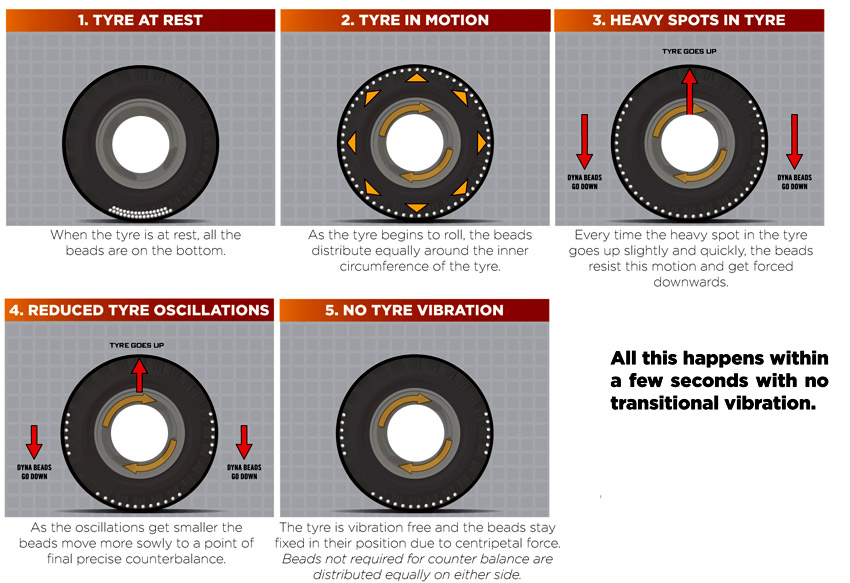The Story: Modded my chunky 1800cc cruiser with a non-standard phatty front tire for personal comfort, handling and style reasons. Came back from the garage with CRAZY out-of-balance vibrations at most speeds, becoming *dangerously* wild at highway speeds. Didn't want to take it back to the garage who balanced it as they already didn't like the idea of the non-standard tire (which was approved in writing by the tire manufacturer, in addition to many dozens of personal reviews...), so I chose not to engage that battle with the garage and after some research went with these beads instead. Removed all the weights on front *and* back wheels, installed the beads per instructions (eZpZ - just a bit of patience and about 10mins per tire - recommend using a bike lift to hold it while loading), pumped the tires back to proper pressure and have put about 1000kms on them since - HOLY COW!! Like NIGHT and DAY compared to what must have been *wildly* incorrect weights applied by the garage.
Plus, now I don't have any unsightly weights on my rims. Beads work AWESOME - smooth as silk, no noticeable "start off" unbalance feel whatsoever (they claim static holds them in place for brief stops). HIGHLY recommended - wish I did them from Day 1. Enjoy.
2016 M109R
Happy Happy Joy Joy 3 years ago
August 17, 2021
I've been using Counteract Balance Beads for yearson a 2004 Yamaha FZ6 (for approximately 60,000 km and 3 or 4 sets of tires), a friend's Honda NC700x, and now I'm also using them in a 2012 Yamaha WR250R (tubed motorcycle). I believe that they increase the life of the tire - and of special note my front tires don't cup anymore either. No feeling of 'out of balance' ever from installation (which I do myself) to the end-of-life removal of the tire. FWIW, if you get a puncture, don't use a 'slime' type product as then the beads will not be able to move to the light spots in the tire anymore.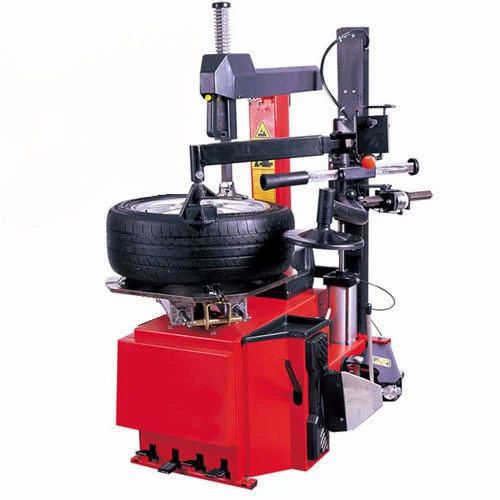 You can't throw a balance bead like you can a weight, and they're easier on the rim too. They're much easier to use than trying to balance perfectly with weights as well. I also reuse them when I change tires.
You can't throw a balance bead like you can a weight, and they're easier on the rim too. They're much easier to use than trying to balance perfectly with weights as well. I also reuse them when I change tires.
2004 Yamaha FZ6
Southeast Steve August 2021
After lacing a new rim on my bike, I had a vibration at around 60. Tried putting some balance beads into the existing tube, but that didn't quite get rid of the shake. I decided to try this tube with beads already in it, and that fixed it! Going to get one for the rear soon.
Dustin · Review provided by revzilla.com
May 26, 2020
It doesn't really cost any more than a standard tube + Counteract beads, and having the beads already in the tube makes the job easier (unless you have really balance poor knobbies like Dunlop 606's ... then maybe you'll need more beads in the tube). The tube itself feels like a quality product and the valve looks to be of high quality too.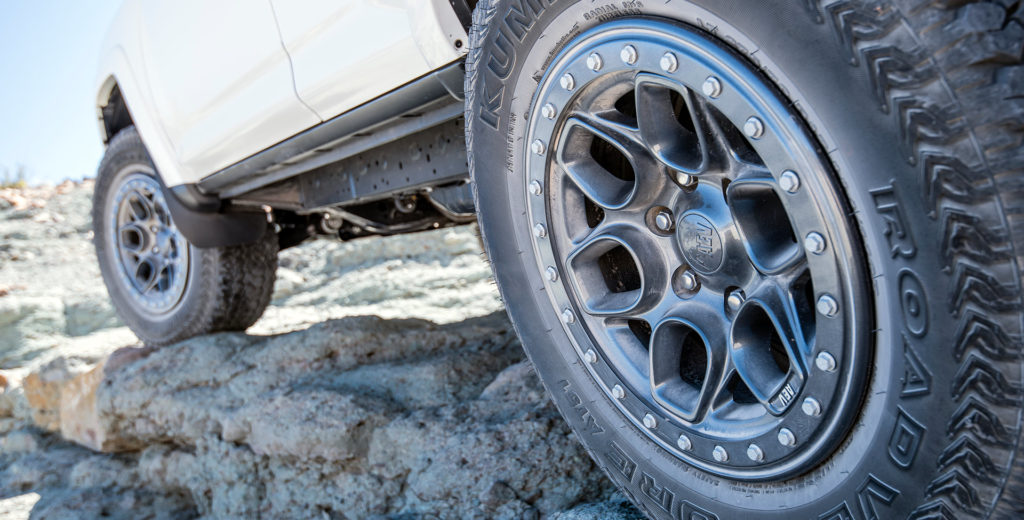 I'm using this one on a 2012 Yamaha WR250R. Future Ready-balance tubes will get used on a 1999 BMW F650 and on the rear of the WR as well. Southeast Steve · Review provided by fortnine.ca
I'm using this one on a 2012 Yamaha WR250R. Future Ready-balance tubes will get used on a 1999 BMW F650 and on the rear of the WR as well. Southeast Steve · Review provided by fortnine.ca
August 17, 2021
I checked this product out on line, was a little skeptical at first, but watched a few videos and read the reviews from other sites. Since removing the stick on weights and adding the beads the difference has been incredible. Very smooth all vibration is gone, I highly recommend this product and am now considering purchasing more and using them on my car as well. I recommend them to all my bike riding friends.
Jeff- 6 years ago
2009 Suzuki M90
Read a lot of reviews here and elsewhere that claimed this was a long process, didn't work, junk, etc.. Well I read the instructions and installed the beads EXACTLY like the instructions said. Pouring a little at a time down the valves was the main point to follow. It took a total of maybe 5 minutes per wheel to do. To me this was just an experiment as I already have a wheel balancing machine and have balanced many wheels in the past. A bonus is no weights to fly off or get knocked off. Chanced tires and tubes, filled up with beads and took off. ZERO issues with wobbles or air leakage. My days of balancing motorcycle tires are over. A bonus feature: If you keep a kit in your roadside emergency repair kit you can balance your tire while doing a roadside repair.
It took a total of maybe 5 minutes per wheel to do. To me this was just an experiment as I already have a wheel balancing machine and have balanced many wheels in the past. A bonus is no weights to fly off or get knocked off. Chanced tires and tubes, filled up with beads and took off. ZERO issues with wobbles or air leakage. My days of balancing motorcycle tires are over. A bonus feature: If you keep a kit in your roadside emergency repair kit you can balance your tire while doing a roadside repair.
August 17, 2021
I have done about 8 tires now with the balance beads and am convinced that this is the only way to go. The first set of tires took me on a 8000kms journey on rough roads before the tire wore down. i was curious of what the beads looked like after all these miles. I figured that they would be worn down and powedered up, but looked like new. I was carefull and pulled them out of the old rubber and reinstalled in the replacement tires. The inside of the old rubber was not effected by the beads at all. I am saving about $50 per tire by doing this myself. So far for me that is a $400 savings.
I figured that they would be worn down and powedered up, but looked like new. I was carefull and pulled them out of the old rubber and reinstalled in the replacement tires. The inside of the old rubber was not effected by the beads at all. I am saving about $50 per tire by doing this myself. So far for me that is a $400 savings.
I was skeptical at first, but determined to change my own tires and balance them myself. I thought I'd try this before spending big money on a static balancing set up or going through the trouble of making one.
I was sure it sounded too good to be true, but I've been really impressed. I've put on a couple of hundred KMs with the balance beads at varying speeds. My old tires must have come out of balance a bit through wear, because I can feel a very big difference in the vibration at speed - much smoother now.
I have a BMW R1100GS and put 3oz in the rear and 2oz in the front. It wasn't quick, or fun to put them in, but it was a small price to pay. The kit is very well thought out too. I was impressed that they even provide the extra valves and caps. Its a nice touch.
I'd definitely recommend these. Its not just snake oil.
#TEAMCOUNTERACT
We’re looking for our Counteract Fans! Post a photo/video/review about Counteract on social media* and tag us using #teamcounteract and /or @counteractbalancing for a chance to win a $100 Amazon Gift Card or a DIY kit of your choice.
To qualify you must be following @counteractbalancingAll valid entries will be entered into two draws:
1) Weekly draw for a **DIY kit of your choice.
2) Monthly draw for a $100 Amazon Gift Card.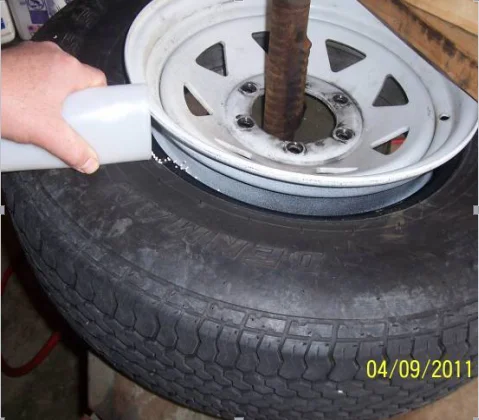
Participants can enter as many different posts as they want. Each different post qualifies as an entry. Winners are only eligible to win 1 draw per month.
*LinkedIn, Instagram, Facebook or Twitter. Please make sure you’re following our account on the platform. Post to multiple platforms for more chances to win.
**DIY Kits Available
Counteract is the ONLY balancing product on the market proven to improve fuel economy in two separate S.A.E and TMC type II tests. We were the first to market 100% glass beads for balancing. Don't be fooled by competitive claims, Counteract's technology makes it the most technologically advanced system on the market today.
The amount of Counteract needed is determined by the vehicle and the tire size, and in some cases the aggressiveness of the tread. Try our handy calculator to find out exactly what is recommended for your tire.
No, Counteract does not void any tire warranties. Due to our advanced technology Counteract does not harm the inside of a tire, once removing Counteract from a tire you would never know it was inside. Warranties are only voided if the internal balancer has caused harm to the interior of the tire carcass, or you can tell that something was installed inside the tire. None of these happen using Counteract.
Having too many beads inside the tire in some cases can cause a slight imbalance. This is a concern on smaller tires where there is not as much room in the tire cavity for the beads to evenly spread themselves where they need to be. When there is too much, it can create a "traffic jam" where the excess beads get forced into the wrong balance position creating an imbalance. There is certainly an ideal amount of product to have inside the tires, as directed by our application charts. The smaller the tire, we need to be precise, the larger the tire, such as commercial tires or off-road tires there is much more room to allow for extra product without hindering the performance. We will always recommend referencing from our chart, and we always remind customers to make sure they are referencing the proper chart as we do have specific charts for specific applications.
The smaller the tire, we need to be precise, the larger the tire, such as commercial tires or off-road tires there is much more room to allow for extra product without hindering the performance. We will always recommend referencing from our chart, and we always remind customers to make sure they are referencing the proper chart as we do have specific charts for specific applications.
Yes, Counteract is re-usable. However, you must be careful when re-using the product. When we manufacture our product it goes through a special decontamination and cleansing process. When you re-use it you could lose some beads or contaminate them which could cause the product to not work as effectively. For the price and extended tire life you receive using Counteract it makes sense to put in fresh product.
No, our truck beads and our motorcycle beads are different. They go through different refining process and are manufactured differently.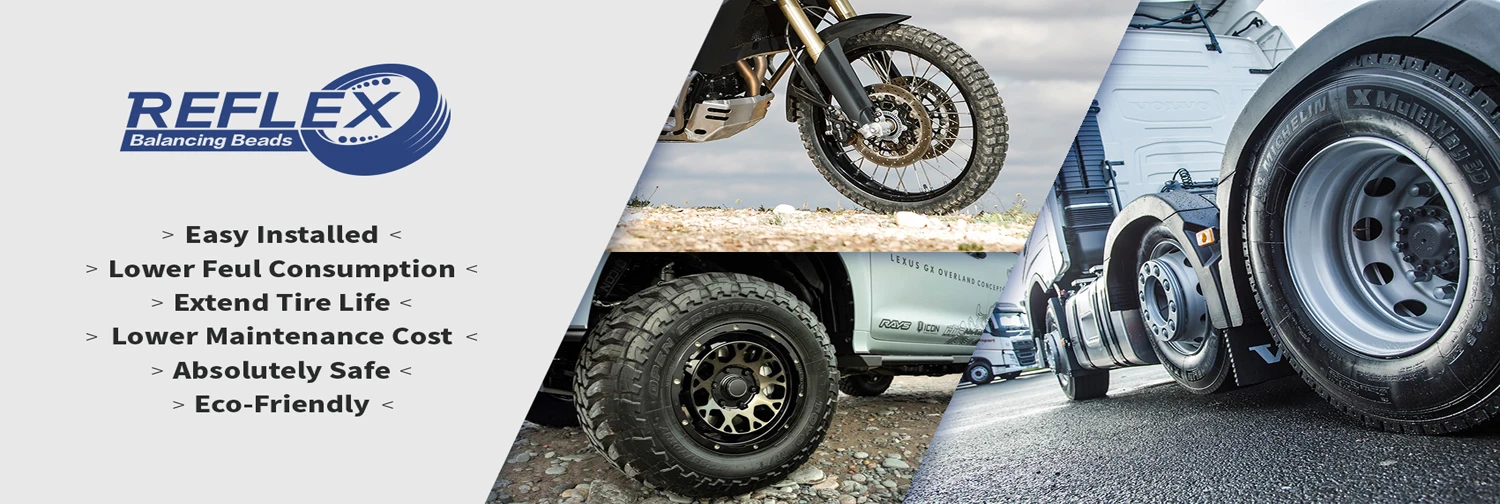 Motorcycle tires are different then truck tires, so are our beads. If you use the truck beads in a motorcycle we will not honor any warranty claims or support any issues that may arise.
Motorcycle tires are different then truck tires, so are our beads. If you use the truck beads in a motorcycle we will not honor any warranty claims or support any issues that may arise.
No, Counteract Balancing Beads will not react with any known metal or materials.
No. The Counteract Balancing Beads will only move to the balanced position through inertia generated by the out of balance condition of the complete wheel assembly and the up and down motion of the vehicle suspension.
It is not advised to combine other internal balancing agents or balancing rings with Counteract Balancing Beads. It is recommended that all other types of balancing be removed so as not to hamper Counteract Balancing Beads from balancing the wheel assembly properly.
Counteract Balancing Beadshas proven that we allow tires to run 30 degrees cooler than a traditional spin balance, and 60 degrees cooler another popular internal balancer. Counteract actually keeps your tires running cooler, helping eliminate thermal degradation and irregular wear.
No, you should not combine weights with the use of internal balancers. The reason being is they work against each other. If you have a balance issue, you only need Counteract.
Counteract is 100% TPMS compatible. Counteract can and should not be injected through the valve stem if it has TPMS sensors, in this case you must install the product while the tire is broken or while being mounted.
Counteract is a balancing product.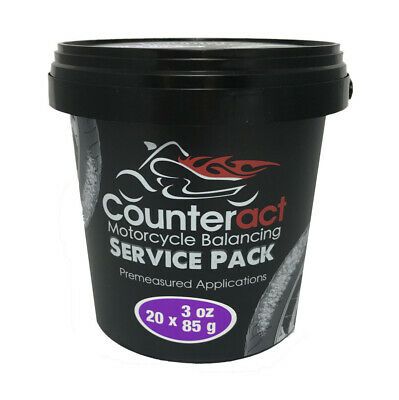 If there is an imbalance with your tires Counteract will remedy the problem. However, no balancing product can fix a bad tire, bent rim or mechanical problem. If you need help troubleshooting a vibration issue, please feel free to submit this troubleshooting form and we'll contact you to help resolve your issue. Click Here
If there is an imbalance with your tires Counteract will remedy the problem. However, no balancing product can fix a bad tire, bent rim or mechanical problem. If you need help troubleshooting a vibration issue, please feel free to submit this troubleshooting form and we'll contact you to help resolve your issue. Click Here
Counteract does not recommend the use of internal balancing products in most automobile tires (the exception being classic cars). For a detailed explanation click here
When you put a lift kit on a vehicle, it changes the angle of the driveshaft, rendering the driveshaft itself unbalanced. This can cause the vibrations that are sometimes mistaken for tire balance vibrations. No matter what you do to balance your tires in this situation, it won't eliminate the driveshaft vibration. To learn more, check out this article by 4WheelParts Click here
Our application charts are based on a stock vehicle with stock wheels and no modifications.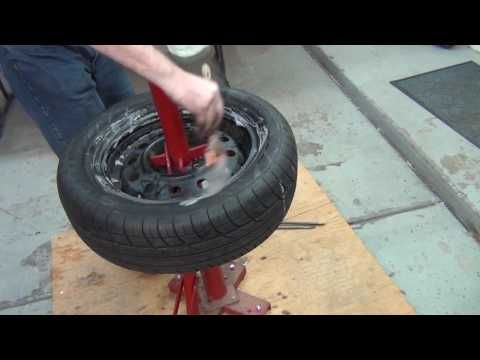 In many cases, when a vehicle is modified it changes the dynamics and drive-ability of that vehicle. In those instances, our recommended amount may, or may not be enough to compensate for the tire imbalances. It is also to be noted that when a vehicle has aftermarket wheels, lift kits or other aftermarket components, there are many more possibilities for vibration that may not be tire balance related. Counteract will balance a tire, wheel and its entire rotating assembly. It will not fix an alignment issue, driveshaft imbalance, or harmonic vibrations from an aggressive tire tread.
In many cases, when a vehicle is modified it changes the dynamics and drive-ability of that vehicle. In those instances, our recommended amount may, or may not be enough to compensate for the tire imbalances. It is also to be noted that when a vehicle has aftermarket wheels, lift kits or other aftermarket components, there are many more possibilities for vibration that may not be tire balance related. Counteract will balance a tire, wheel and its entire rotating assembly. It will not fix an alignment issue, driveshaft imbalance, or harmonic vibrations from an aggressive tire tread.
No, Ambient moisture does not affect the product's performance, this is due to our special coating.
Counteract Balancing Beads are made of recycled tempered glass and do not break down when used in tires, the evidence of this is in millions of applications sold since introduction in 1997. Not one case of this problem has ever been reported.
Counteract Balancing Beads are easy to remove. The simplest way is to use the Counteract Air Powered Bead Vacuum which allows you to quickly vacuum beads out of a tire, avoiding messy spills. Alternatively you can sweep the beads into a pile inside the tire and scoop them out. Always be careful not to spill the beads onto your work surface.
<pValve clogging is not a common problem with Counteract Balancing Beads and is usually the result of dust (we remove all dust at the manufacturing stage). A valve filter may help but can also slow down air flow or become clogged itself by dust, making it difficult to check air pressure. To address this situation the beads are selected by size and put through multiple screening and dusting processes. To reduce the possibility of a valve leak, it is recommended to use a Counteract Valve Core and self sealing valve cap (supplied in every package).
</p
The reason we do not sell bulk pails of Counteract is due to multiple issues. If we have shop users weighing out their own beads and putting them in tires, we cannot guarantee that their scale or scoop is accurate to our required tire size measurements. We package the bags individually for specific tire sizes so that there are no issues. It allows us to have control over what is being installed into the tire, therefore we will help with any support needed. If you weigh your own, you’re on your own and we are not responsible if anything goes wrong. Also, as mentioned before, our product has a special decontamination and cleaning process, if users weigh out their own they can contaminate the product and cause issues.
No, Counteract is not compatible with any tire sealant or slime. Do not combine these products.
Useful information
— Why are wheels balanced?
— How important is balancing accuracy?
— What is the imbalance of the wheels?
- What imbalance is considered normal?
Many car enthusiasts often do not think about the importance of such a simple procedure as wheel balancing, without paying due attention to it.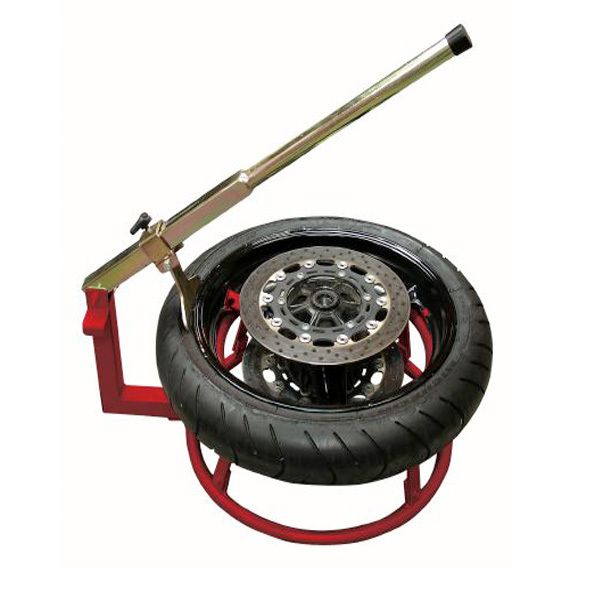 But the automaker recommends balancing the wheels at least 2 times a year (before the winter and summer periods) or every 10,000 km. Run.
But the automaker recommends balancing the wheels at least 2 times a year (before the winter and summer periods) or every 10,000 km. Run.
It is unlikely that today there are still car enthusiasts who need to be convinced that tire balancing is a must. At the same time, far from everyone, unfortunately, understands and realizes the role that balancing plays in ensuring traffic safety and therefore pay too little attention to the quality of balancing (including the choice of a tire shop), as well as the quality of tires and wheels, which are offered on the market.
Why are wheels balanced?
The answer to this question is known, if not by everyone, then at least by most motorists: the mass of the wheel must be evenly distributed relative to the center, and then the vibration of the wheel will be minimized. But why is this needed, and how can it affect durability, safety, comfort and other important points for us? Without going into details, a simplified answer to this question may look something like this: in the case when the wheel is not balanced in all axes of symmetry, unbalanced centrifugal forces with different application vectors arise, which creates wheel vibration and multidirectional loads on the hub. This, in turn, leads to the following consequences:
This, in turn, leads to the following consequences:
- Under the influence of loads unforeseen by the automaker, the bearing suspension units wear out much faster (hub bearings usually suffer first of all), and with a significant increase in such loads, there may be a threat of sudden destruction of these units.
- The consequences of losing a wheel at high speed, I think, do not need additional explanations.
- A vibrating wheel has significantly poorer traction (unstable contact patch), resulting in poor handling and longer braking distances. All this significantly reduces the level of driving safety.
- Uneven load on the tread due to wheel vibration leads to a significant reduction in tire life - the tire simply wears out faster.
- Strong vibration of the front wheel is transmitted to the steering wheel, which creates discomfort for the driver.
How important is balancing accuracy?
The unbalanced mass of the wheel during its rotation creates its own centrifugal force, with its own application vector. We recall the school physics course: the formula for calculating centrifugal force:
We recall the school physics course: the formula for calculating centrifugal force:
F=mw²R
Where m - in our case - unbalanced mass, w - angular velocity (speed of rotation), R - radius of removal of unbalanced mass from the axis of rotation. We see that the magnitude of the centrifugal force depends on the speed of rotation, the unbalanced mass and the radius from the axis to the unbalanced mass. Based on this, we can draw the following conclusions: with an increase in speed, the destructive effect and all the negative consequences of an unbalanced (poorly balanced) wheel increase significantly, the tire has the greatest influence on the general condition of the wheel, because it is it that is the most distant from the axis of rotation. Thus, the higher the average vehicle speed, the more critical the quality of wheel balancing and the more dangerous the consequences of poor-quality balancing.
What is wheel imbalance?
Unbalance can be static or dynamic.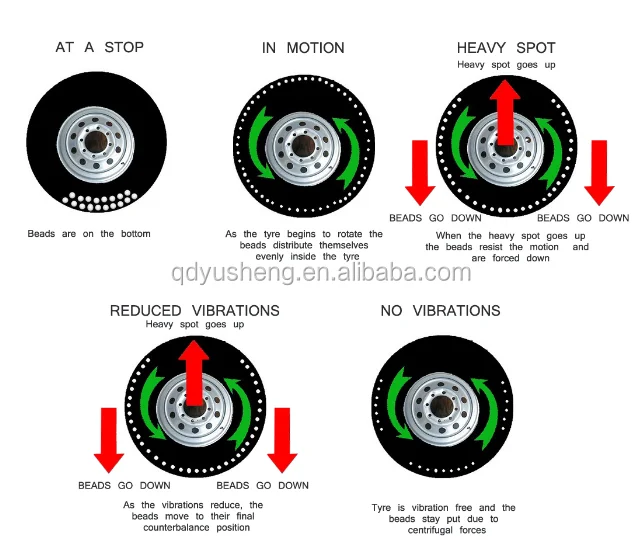 In both cases, we are talking about a mismatch between the axes of rotation and inertia (the latter passes through the center of gravity of the wheel). Let's try to decipher these terms in an accessible language. Static imbalance occurs when the axis of rotation of the wheel is parallel to the axis of inertia and the center of gravity is not on the axis of rotation (the mass of the wheel is unevenly distributed along the circumference). In this case, putting the wheel on a freely rotating axle, you can observe how the wheel will make several pendulum movements and stop when the center of gravity of the wheel is at its lowest point. Dynamic imbalance occurs when the center of gravity is on the axis of rotation, but the axis of inertia does not coincide with the axis of rotation, crossing it at a certain angle (the mass of the wheel is unevenly distributed over its width). In this case, the unbalance can be determined only during the rotation of the wheel. It is the dynamic imbalance of the wheel that the craftsmen eliminate by installing compensating trucks on both sides of the disc rim in certain places.
In both cases, we are talking about a mismatch between the axes of rotation and inertia (the latter passes through the center of gravity of the wheel). Let's try to decipher these terms in an accessible language. Static imbalance occurs when the axis of rotation of the wheel is parallel to the axis of inertia and the center of gravity is not on the axis of rotation (the mass of the wheel is unevenly distributed along the circumference). In this case, putting the wheel on a freely rotating axle, you can observe how the wheel will make several pendulum movements and stop when the center of gravity of the wheel is at its lowest point. Dynamic imbalance occurs when the center of gravity is on the axis of rotation, but the axis of inertia does not coincide with the axis of rotation, crossing it at a certain angle (the mass of the wheel is unevenly distributed over its width). In this case, the unbalance can be determined only during the rotation of the wheel. It is the dynamic imbalance of the wheel that the craftsmen eliminate by installing compensating trucks on both sides of the disc rim in certain places.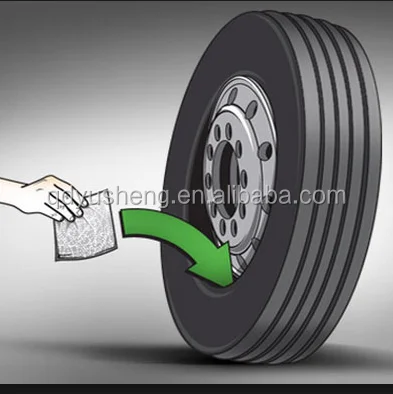
What imbalance is considered normal?
Of course, it is impossible to make a perfect wheel, and since we are talking about a disk-tire set, the quality of the complete wheel directly depends on the quality of each of these components. Therefore, there are certain ranges - tolerances within which the existing imbalance is considered accessible.
Equipment or human factor?
What has more influence on the end result of wheel balancing, a wheel balancing machine, or skilled craftsmen? In general, both are in approximately the same ratio. Experienced craftsmen say that anything can be balanced “to zeros”, but this does not mean that the wheel will be suitable for safe use for its intended purpose. If you can evaluate the qualification (attitude to work) of the master by indirect signs, then the accuracy and condition (calibration) of the balancing machine, alas, cannot be done. Therefore, try to avoid balancing the wheels in "roadside" tire repair shops that are unfamiliar to you - such balancing will most likely have to be rechecked.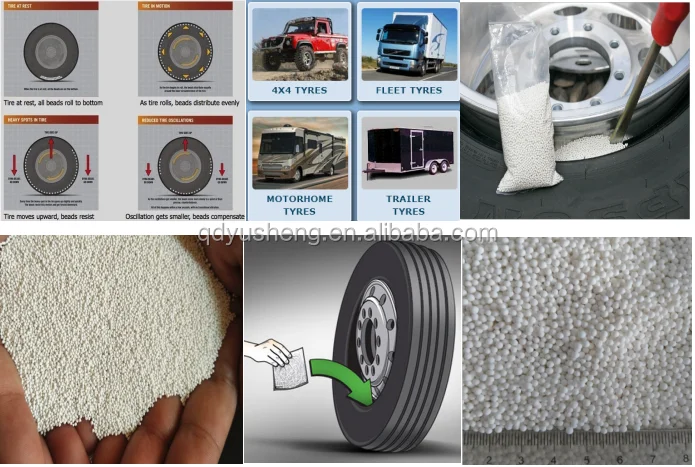
12/17/2020
LADA
UAZ
KIA
Hyundai
Renault
Toyota
Volkswagen
Skoda
BMC
BMAN
BMARS
BMAN
Mitsubishi
Mazda
Ford
All brands
We analyze in detail in which cases it is necessary to re-balance the wheels.
Related materials
Seasonal tire change: everything car owners need to know
To begin with, a small educational program. Balancing is the alignment of the center of mass of the wheel with the axis of rotation. In this case, the loads are fixed opposite the heavy part of the wheel. This is the definition of static balancing. And since the wheel is not a thin disk, but rather a wide roller, the so-called dynamic balancing is necessary, when loads are placed both on the outer and on the inner parts of the wheel disk.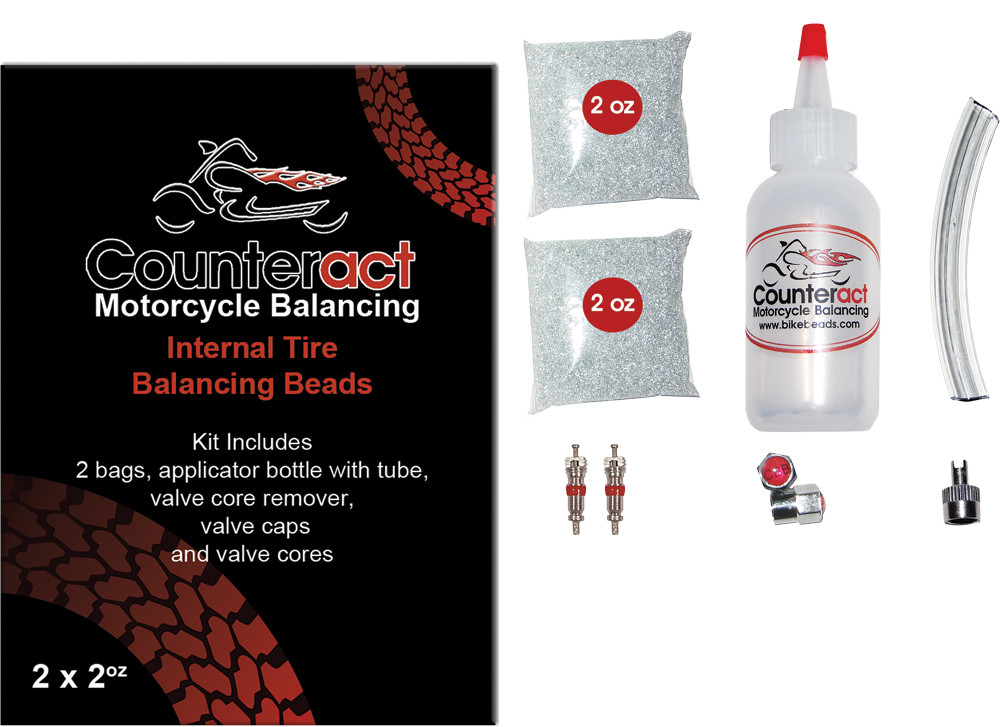 Naturally, the wheels need to be balanced immediately after mounting the tire on the rim: after all, the imbalance can reach 50–60 g on each side. If it turns out more, then it makes sense to "twist" the tire relative to the disk, ensuring their mutual rotation by 180 degrees. With this initial balancing, tire workers provide an imbalance of less than 5 g per side. It is believed that a new tire is capable of slightly changing its position on the disk in the first kilometers, and therefore the balancing will go away a little.
Naturally, the wheels need to be balanced immediately after mounting the tire on the rim: after all, the imbalance can reach 50–60 g on each side. If it turns out more, then it makes sense to "twist" the tire relative to the disk, ensuring their mutual rotation by 180 degrees. With this initial balancing, tire workers provide an imbalance of less than 5 g per side. It is believed that a new tire is capable of slightly changing its position on the disk in the first kilometers, and therefore the balancing will go away a little.
Now let's turn directly to our topic. If you alternately install either winter or summer tires on the same wheels, then you cannot avoid balancing. There is nothing to argue about here. The question of balancing every season arises only for those car owners who have two complete sets of wheels: summer and winter.
Related materials
Routine work that everyone ignores (and in vain!)
So, should the wheels be balanced at every seasonal change?
If you approach the process formally, then you should remember the instructions for the car.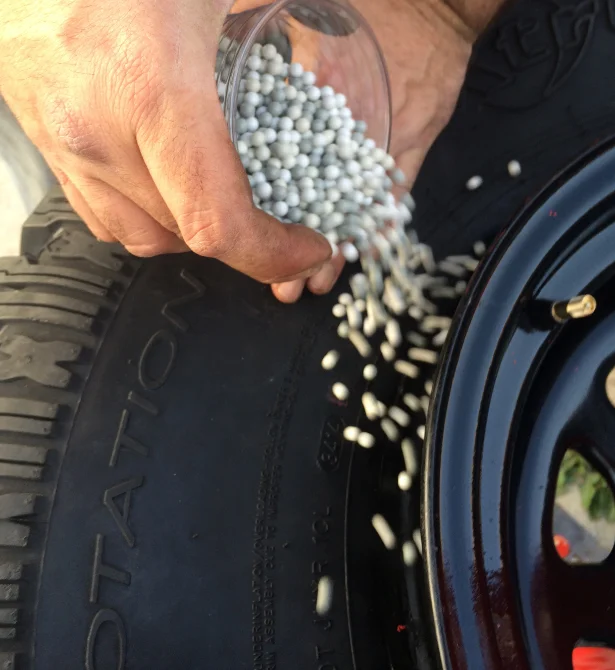 It is usually recommended to balance the wheels after a run of 10,000 to 15,000 km. If you drive less in one season, then you definitely shouldn’t balance, except for the cases specified below.
It is usually recommended to balance the wheels after a run of 10,000 to 15,000 km. If you drive less in one season, then you definitely shouldn’t balance, except for the cases specified below.
But this is in theory, but in practice I advise you to monitor the behavior of the car. If there is no noticeable beating of the steering wheel, then balancing is not needed. The beating of the rear wheels is felt less, but they usually suffer less often. In any case, you should feel a strong imbalance.
If you change your own wheels twice a year, the following recommendation applies. Put the wheels on and ride for a couple of days. During this time, the tire will get rid of the deformations that occurred during storage. If there are no vibrations at any speed with which you drive, balancing can not be carried out.
Related materials
10 procedures without which it is better not to drive
Balancing is required in the following cases:
